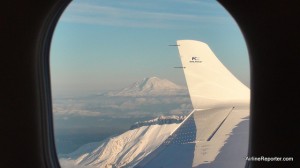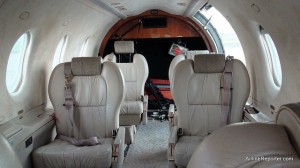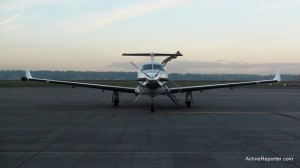You might be an aviation geek if you take a flight, wait around for five minutes, then get back on the plane to fly home. I love doing that stuff and I recently got to fly SeaPort Air from Seattle to Portland to check out their product (disclaimer: I did not have to pay for my flight).
SeaPort Air is one interesting airline. Service started in June of 2008 flying between Seattle and Portland. However they not only fly to additional destinations in Oregon, they also fly to destinations in Arkansas, Kansas, Missouri and Tennessee. Say what? Do not worry, I will explore the airline’s interesting history in another blog. On this one I want to take a look at their flight from Seattle to Portland.

Not a shabby view. Nice thing about a small plane is you can take photos out of your neighbor's window.
Unlike most other flights out of Seattle, that leave from Seattle-Tacoma International Airport (SEA), SeaPort flies out of King County International Airport (aka Boeing Field – BFI), which is located just north of SEA. The big benefit of operating out of BFI is no TSA. That means, no privacy invading body scanners, no putting your toiletries into a ziploc bag and no waiting in long lines. SeaPort has no problem advertising the lack of TSA. On their website they state, “No lines. No rubber gloves. No need to take your shoes off. Simply arrive 15 minutes before your flight, board and go.” What a simple concept. SeaPort shares a common ticket and boarding area with Kenmore Express, the only two scheduled airlines that currently operate out of BFI.

This aircraft was in executive configuration. Yes, that is suede on the walls and ceiling -- classy.
SeaPort is geared towards the business traveler. They fly the Pilatus PC-12 which they have set up to hold 6-9 passengers. My flight was in an executive configuration of six passengers and I got to sit backwards flying south (photo of commuter configuration). With the pressurized cabin, turboprop engine and executive layout, the flight really felt VIP. During flight, the Pilatus felt much larger than other aircraft of the same size.
My big regret was not sitting on the left side of the plane on the flight down to Portland. Even though it was the middle of November, the sky was clear and there was plenty of great mountain eye-candy to be seen. Luckily for me, the passenger sitting next to me didn’t mine me taking a few shots out his window (he was sleeping). When coming back to BFI I wanted to sit on the right side to catch the views I missed on the way down. However Christian, one of the pilots, suggested I sit on the left side. He explained we would be doing a fly-by of downtown Seattle on a northern approach to BFI and it would be worth it. I took his advise and I am glad I did. Unfortunately it was night time by the time we reached the city, which provided an amazing few, but taking photos was difficult (photo).
Speaking of pilots, you will find two of them upfront. Airlines are able to fly with only one pilot on the Pilatus PC-12, but SeaPort has decided to fly with two. This is an unusual business decision, since not only does the second pilot cost more money, they also take up a seat that could be used for revenue. Although most passengers prefer having two pilots, I prefer only having one, since that gives me a chance to sit in the empty co-pilot’s seat.
Even though there is no direct BFI-PDX competition, both Horizon (with their their Q400’s or CRJ700’s) and United Express (with their E120s) fly on the SEA-PDX route. Flying on SeaPort Air via BFI versus others airlines at SEA definitely has some benefits. Passengers get free parking both at BFI and SeaPort’s terminal at PDX and of course you don’t have to deal with TSA at either. Even though SeaPort’s ticket prices might be a bit higher, when you factor in free parking and no bag charge, the overall cost becomes very competitive.
Time, especially with business travelers, can be worth much more than money. When I landed back at BFI, from the time the plane was stopped, to me pulling out of the parking lot in my car it was about three minutes (yes I was timing it). Try doing that at SEA.
